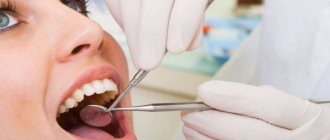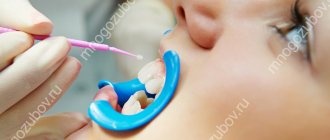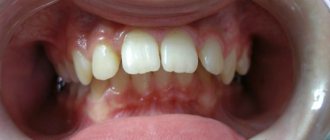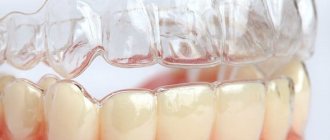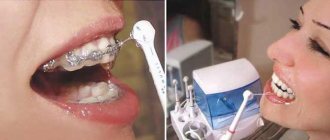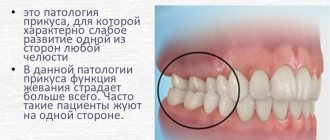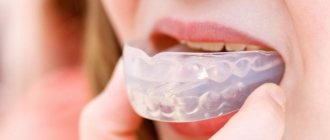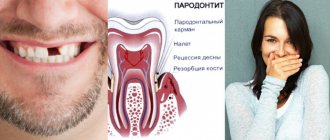2578
When a client of a dental clinic needs to install a prosthesis, crown or veneers, wax modeling of the teeth must be a mandatory step in preparation for this procedure.
It is this type of preparation that allows the patient to see his future smile and check the comfort and accuracy of the future design.
General overview
This technique in dentistry is otherwise called Wax-up technology, which is a mandatory step in the orthopedic correction of oral defects.
Making a model in dentistry is necessary for the following purposes:
- Drawing up plans for the upcoming restoration by the orthopedic doctor and technician. The wax model is a test material, from which they clearly determine the method of restoring the damaged unit, consider the possible nuances and difficulties of prosthetics, and the scope of further work.
- Making it easier to explain to the patient all the features and aspects of the upcoming treatment , as well as agreeing on the final appearance of the teeth after their restoration.
- Elimination of all inaccuracies and inconsistencies of the future prosthesis at the initial stage of its manufacture.
To perform such work, wax is considered the most suitable material. When heated, it is quite plastic, amenable to any processing, and after cooling it easily and quickly takes the required shape.
In addition, this material is durable and dense. These properties help the technician to very accurately reproduce the required parameters of the tooth so that the manufactured prosthesis is as similar as possible to the original.
It should also be noted that not a single type of dental work can be done without aligning teeth with wax. This stage is necessary to work out the nuances of the upcoming work to restore the functionality and aesthetics of the dentition.
General idea and how to model teeth using wax
Modeling teeth from wax is also called the Wax-up procedure, which directly refers to the material itself from which the model will be made.
In other words, Wax-up is a mandatory procedure, without which it is impossible to perform prosthetics or install implants.
Wax prosthetics is based on creating an individual impression of the oral cavity. Based on the finished impression, temporary dentures or crowns will be made.
The resulting wax model provides the basis on which an experienced dental technician will construct the permanent restoration.
To make an impression down to the smallest detail, dentists restore destroyed or damaged teeth using liquid wax.
At the moment when the wax hardens, the specialist has the opportunity to see how accurate the contact of the formed temporary prosthesis is with the antagonist tooth.
At this point, it is important to determine how correctly the chewing load is distributed in the oral cavity. The patient should be as comfortable as possible and should not have any unpleasant sensations.
Having collected all the necessary data, the doctor begins to plan treatment therapy and the subsequent stage of prosthetics.
Material requirements
Types I and II wax are often used for wax-up. The first type is appropriate to use for modeling using the direct method, and the second type for the indirect method. This is due to the fact that the second type of wax is of lower quality, which does not in any way affect the result of the impression.
Also read: Mouthguard for teeth: what is it, what is it for and its cost
The first type of wax is an ideal option for modeling structures directly in the client’s oral cavity.
There are several rules for the selection, storage and use of waxes, namely:
- To achieve greater contrast, it is better to use colored waxes, such as red or blue.
- After cooling, the material should retain its rigidity, but not crumble.
- During the heating process, there should be no crumbs in the wax mass, which can affect the quality. Crumbs and flakes in the mass can create a textured surface rather than a smooth one.
- During the scraping process of the model, the material should not fall off in pieces or form chips.
- Wax should not be stored longer than the permissible period, as this may affect its quality.
In order for the model to be high-quality and accurate, it is necessary to select the correct wax depending on the modeling method.
Indications
Wax-up technology is recommended and used for any indirect aesthetic restoration, namely for crowns, lumineers, bridges, veneers.
Thanks to the creation of wax models, the final result from the production of these products is calculated as accurately as possible.
The technique is also applicable for correction of parameters (shape and size) of the crown part, as well as for complete reconstruction of the dental form. In the second option, the technology is used:
- in the production of temporary orthopedic products on samples with prepared units;
- for planning the placement of removable and non-removable systems;
- when determining the amount of teeth grinding;
- to evaluate the result of occlusion correction on a diagnostic model;
- when planning the exact placement of implants with immediate subsequent loading.
Wax modeling can also be used for orthopedic correction of defects in the location of teeth, for example, when correcting the progenic conformity of the jaws.
Why is mock-up technology used in prosthetics?
Today, patients have very high aesthetic requirements for a smile. But, you see, the concept of beauty is subjective. Some patients focus on the smile of public people, wanting to get an exact copy. Only a few people think about how “other people’s” teeth will look surrounded by their own volume of soft tissue (gums), the color of their lips, and against the background of their individual skin tone.
Before treatment
In order to demonstrate to the patient the shape and size of future teeth even before the start of treatment, the orthopedic dentist takes impressions (casts) of the jaws. Based on the impressions obtained, plaster models are made in a dental laboratory.
Diagnostic plaster models.
Using the resulting plaster models, dental technicians in the laboratory perform wax modeling of the future shape, size, and volume of ceramic restorations (wax-up). At the same time, an exclusive option is created for each patient, optimally suited for a specific clinical situation, taking into account the wishes of the patient himself.
Plaster models with wax modeling of teeth.
Similarly, it is possible to obtain an optical impression. In this case, the technician models the teeth using a computer program. With the help of simple manipulations, the formed volume of teeth is transferred to the patient’s oral cavity using temporary plastic restorations (mock-up).
Thus, a kind of fitting of future restorations takes place, but for now in plastic, which can be easily removed.
As a result, we get not only a new smile, but also correct closure of the teeth (occlusion) in the correct physiological position of the lower jaw (when treating patients with normalization of occlusion in the neuromuscular position of the lower jaw). The patient sees a prototype of future permanent restorations, can evaluate his smile, and check his diction. At this stage of treatment, if necessary, correction is made in the shape, size, and inclination of the teeth. During the transfer of wax modeling of teeth into the oral cavity (mock-up), it is even possible to choose the desired color of restorations from a palette of plastics, so that the patient appreciates the harmony and beauty of the smile.
After the shape and color of future teeth have been approved, the main stage of treatment can begin, which will be completed by fixing permanent ceramic restorations. Moreover, the size, shape and volume of permanent restorations exactly correspond to the temporary ones, which were individualized by the orthopedist and approved by the patient at the preparatory stage of treatment.
Mock-up. After transferring the wax modeling into the oral cavity.
Thus, mock-up technology allows the patient to see and try on their future teeth even before creating permanent restorations.
Contraindications
Modeling using wax is a painless and completely safe procedure for humans. The technique does not cause any unpleasant sensations or discomfort and does not involve the use of painkillers.
Since only natural raw materials – beeswax – are used to build models, the technology has only one contraindication for use. Patients who experience an allergic reaction to honey itself or beekeeping products should not undergo this procedure.
Important! If there is a reaction to honey, the patient is obliged to warn the specialist about this. He will select a different, safer method of prosthetics and restoration for him.
Methods
Two simulation options have been developed:
- Direct.
- Indirect.
In the first option, a composite sample is created based on a wax model directly in the mouth. In this option, both the aesthetics of the tooth and its functionality are created at once.
That is, initially the technician performs modeling on the model and transfers the final version of the sample to the orthopedist at the clinic. There, the specialist demonstrates it to the patient, then transfers it to the mouth, using a special technique.
A temporary system appears in the patient’s mouth, with which, after some time, he will be able to evaluate the correctness and convenience of the sample made. If there is a need to adjust it, the doctor performs it directly on temporary units.
The direct modeling method is suitable for patients who have high enamel abrasion, problems with the mandibular temporal joint, and if they need to increase their bite.
If the patient has no complaints about the model, then it is sent to the laboratory to produce a permanent structure.
In the second option, a sample of the future prosthesis is formed on a plaster base (stump). The technician presents the resulting model to the patient, and only after he approves the result, he begins to manufacture a permanent structure.
In this case, modeling is necessary only to show the result.
The direct method has several advantages over the indirect method:
- The accuracy of the wax sample is higher.
- It is possible to eliminate identified deficiencies and inaccuracies.
- You can precisely adjust the boundaries of the future prosthesis in the area of the gum margins.
- The articulatory relationship between the restored unit and the antagonizing one is taken into account.
But, at the same time, the direct method has difficulties with viewing remote areas, i.e. it is quite difficult to correct inaccuracies on the lateral groups of teeth.
There is also a risk of accidental damage to the mucosa with the instrument when adjusting the model.
The purpose of taking dental impressions and the materials used.
Read in the next article the characteristics of steel crowns for teeth.
At this address https://www.vash-dentist.ru/protezirovanie/nesemnyie-p/viniryi-np/duo-pch-estestvennaya-krasota.html we will talk about the features of Duo PCH veneers.
Wax modeling technique
Wax-up modeling is carried out according to the following algorithm :
- Impressions (casts) are taken.
For this purpose, special silicone is used, and impressions are made both from the jaw, where the temporary structure will be installed, and from the opposite one. The final stage is demonstrating the work to the patient.
- The closure of the jaws is fixed. For this purpose, bite rollers are used, which are also made of silicone.
- Obtaining models of both jaws with the trajectory of their movement. For this purpose, a face bow is used - a plate capable of recording the movements of the jaws, which is attached in the area of the ears.
- Making samples based on the data obtained, transferring them in plaster to an articulator - a device capable of simulating jaw movements.
- Making wax models on plaster blanks and demonstrating the work to the patient.
If the wax model is converted into a Mock-up, then the result is transferred to the growth cavity:
- Making impressions of new teeth, called silicone keys.
- Plaque removal. No preparation or grinding is required to install temporary structures.
- Applying glue that will fix the Mock-up.
- Putting the material (plastic, composite) into a silicone key and applying it to the teeth.
- Removing the key, removing excess material, polishing.
Material requirements
To carry out wax modeling, specialists use only soft material - wax wax or beeswax.
The material for modeling was not chosen randomly. This is a natural, fairly dense and plastic material that does not contain toxins. The model created from wax can be easily adjusted and an ideal cast of the future prosthesis can be made in all respects.
In some cases, carnauba wax can be used instead of bee raw materials. A material of plant origin extracted from the carnauba palm. It is characterized by increased rigidity and hardness, and also has a higher melting point.
To obtain a high-quality design, the material must meet certain conditions and requirements. So, wax must have the following characteristics:
- low shrinkage during cooling - from 0.1% to 0.15% of the total volume at temperatures from 90°C to 0°C;
- fairly good ductility in the temperature range from 40°C to 55°C;
- hardness at temperatures from 35°C to 40°C, ensuring that the sample retains its shape when it is in the mouth;
- homogeneous composition after dissolution.
The raw material should have no delamination or excessive stickiness during processing, and there should be no ash content after burning the sample. It should also not stain the plaster model.
Preliminary. Having placed and secured the artificial teeth with wax, they begin to model the wax bases. Modeling aims to give the wax base and teeth such that they are similar in size and shape to the finished prosthesis that the patient will use, with a small tolerance for processing, grinding and polishing. Add wax to those areas where there is not enough wax. The clasps and all artificial teeth are securely fastened. After the wax has hardened, clean the occlusal and vestibular surfaces of all teeth. For the front teeth, the entire oral side is cleaned; for the lateral teeth, wax is removed only from the occlusal area. Half of the wax is left in the interdental spaces. The base is smoothed, giving it the same thickness. The wax composition is removed from the model and the edges are rounded. With one touch of the burner flame, minor unevenness in the base laid on the model is smoothed out. Final. After checking the design of the prosthesis, the work is returned to the laboratory. If the thickness of the upper base is uneven or excessive, the palatal part is cut out with a heated spatula. Add a little wax to the palatal folds, enhancing the relief on the model. Apply a part of a heated standard base wax plate to this area. They are trimmed within the border and glued to the rest of the base with hot wax. The edge of the artificial gum base is glued along the perimeter to the model so that during plaster casting, liquid plaster does not penetrate into the ditch between the wax and the model and damage the integrity of the prosthesis. So that the base and artificial gum feel natural in the mouth. The vestibular surfaces are made wavy, imitating the walls of the alveoli. The same is done on the oral side in the area of the front teeth on the lower base, the thickness of which is adjusted to 2-2.5 mm for greater strength. The vestibular slope of the alveolar process, as is known, has a different shape and configuration. Sometimes, closer to the transitional fold, it is curved in the oral direction. As a result, undercuts of various sizes appear, called undercut zones. In other words, undercut zones are these niches on the slope of the alveolar process. If there are undercut areas, they are covered with insulating materials or the wax base in these areas is thickened.You might be interested in:
- Wax melting and molding
- Increasing the strength of prosthesis bases.
- Fixation and stabilization.
- Components of a bent clasp. Clasp line.
- Checking the finished denture design in the oral cavity
We recommend reading:
- Rules for the selection and installation of artificial teeth
- Preparing the model for plastering in an accluder
- Occluder
- Clammer
- Occupational safety and ergonomics in dentistry
Preparation
The preparatory stage is of great importance in restoring the integrity and functionality of the dentition.
Important! You cannot begin orthopedic correction of oral cavity defects without conducting comprehensive preparation.
It includes a complete examination of the oral cavity, and if problems are found, their elimination. The specialist’s task at this stage is to create optimal conditions in the oral cavity for performing prosthetics.
Conventionally, the preparatory stage is divided into:
- therapeutic;
- surgical;
- orthodontic.
Therapeutic preparation includes sanitation and professional dental cleaning. Also at this stage, treatment of inflammation and caries identified in the mouth is performed.
If necessary, several more manipulations are expected during treatment:
- replacement of long-standing fillings;
- root canal filling;
- their preparation for securing prostheses;
- treatment of periodontal tissues;
- preparation of teeth (their turning and depulping).
During surgical preparation, “dead units” are amputated, i.e. those that cannot be treated. Their roots, exostoses, hypertrophied gum tissue and mucosal areas, and osteophytes are also removed.
Important! The next stage of preparation can be carried out only after complete recovery, and this takes approximately two months.
The orthodontic stage allows you to change the position and inclination of the teeth, which are supposed to be used as supports for removable or fixed structures.
The fan-shaped arrangement of the chewing elements are also , additional space is created in the dentition for placement of the prosthesis, and incorrect occlusion is corrected.
Preparing for wax modeling
Before you begin the process of modeling your future smile, you need to follow a number of recommendations:
- diagnose the mouth;
- if necessary, do a computed tomography scan and x-ray of the jaw;
- for diseases of the oral cavity, undergo a course of treatment;
- observe the rules of hygiene and sanitize the oral cavity.
Also read: Gum disease. Symptoms and treatment
Only after a complete examination and treatment course can the orthodontist and technician begin to create a Hollywood smile.
Creation technique
Modeling using Wax-up technology is carried out in the following sequence:
- Casts (impressions) are made, and they are taken from the place where the temporary system will be placed, and from the opposite side. For this purpose, the doctor takes special dental silicone.
- The closure of the jaws is fixed using silicone bite rollers.
- Obtaining samples from the jaws with the direction of their natural movement. This can be done using a facebow - a special plate attached near the ears.
- Based on the information received, samples are made , after which they are transferred to plaster.
- Attaching models to an articulator - a device that simulates the movement of the jaws. It allows the specialist to fine-tune the chewing and articulatory movements of the dental system.
- Creating a wax model and demonstrating it to the patient.
If the sample is converted into a Mock-up, then the result obtained is transferred to the oral cavity:
- An impression is taken of the new units , called silicone keys in dentistry.
- Deposits are removed (preparation and grinding for placement of temporary orthopedic products are not carried out).
- Glue is applied to secure the system.
- Putting one of the materials (composite or plastic) into impressions and applying them to the teeth.
Finally, the silicone keys (impressions) are removed, excess material is removed, and grinding and polishing are carried out. The orthopedist, having completed the fixation, evaluates the result from the point of view of aesthetics and functionality.
Wax-up modeling stages
The dental Wax-up modeling process takes place in several stages:
- a plaster or silicone impression of the client’s jaw is taken not only where they will be temporarily placed, but also on the opposite side;
- fixing the jaw from closing by using silicone bite ridges;
- creating jaw samples using a special plate (face bow) attached to the ears;
- Having received the samples, they are transferred directly to the gypsum material;
- fixing the reproduced model on an articulator - a device that simulates jaw functions and allows the technician to establish chewing and articulatory movements;
- modeling a wax cast on plaster models and demonstrating it to the client.
In cases where the mock-up is converted to the Mock-up technique, the resulting sample is transferred into the oral cavity and the following manipulations are carried out:
- receive silicone keys, that is, an impression from new units;
- deposits (plaque, stone) are eliminated without grinding or preparation;
- fix the layout using special glue;
- placing plastic or composite material in impressions and applying it to the teeth;
- removing silicone keys and processing them by grinding and polishing;
- The final point is to evaluate the work performed.
The duration of creating a wax model, depending on the specific structure of the jaw and the location of the procedure, ranges from 20 to 60 minutes.
Advantages
Despite the fact that the use of the Wax-up technique for orthopedic correction of defects in the oral cavity requires a specialist to perform additional work that requires the expenditure of material resources and time, doctors advise not to refuse to perform it for a number of reasons:
- The procedure allows you to prevent inaccuracies in calculations during the production of implants, as well as eliminate identified errors at the first stage.
- Manifestations of unpleasant sensations and discomfort upon completion of prosthetics are excluded.
- The duration of adaptation to new artificial units is reduced to a minimum .
- A person can examine in detail the wax model of the future prosthesis , clarify some of the nuances that interest him, thereby eliminating misunderstandings between the patient and the specialist regarding the vision of the result.
- The simulation does not affect healthy neighboring units and does not damage them.
- The preparation of supporting teeth is performed in a gentle way , which also eliminates discomfort and unpleasant sensations.
An important advantage is the type of material used in modeling. Wax is an inert natural material that does not cause adverse reactions in the body.
What are ultraneers and how do they differ from other overlays?
In this publication you will find reviews about componers.
Here https://www.vash-dentist.ru/protezirovanie/nesemnyie-p/viniryi-np/restavratsii-zubov-e-max.html a detailed description of E Max veneers is offered.
Wax modeling technique
Wax-up modeling is carried out according to the following algorithm :
- Impressions (casts) are taken.
For this purpose, special silicone is used, and impressions are made both from the jaw, where the temporary structure will be installed, and from the opposite one. The final stage is demonstrating the work to the patient.
- The closure of the jaws is fixed. For this purpose, bite rollers are used, which are also made of silicone.
- Obtaining models of both jaws with the trajectory of their movement. For this purpose, a face bow is used - a plate capable of recording the movements of the jaws, which is attached in the area of the ears.
- Making samples based on the data obtained, transferring them in plaster to an articulator - a device capable of simulating jaw movements.
- Making wax models on plaster blanks and demonstrating the work to the patient.
If the wax model is converted into a Mock-up, then the result is transferred to the growth cavity:
- Making impressions of new teeth, called silicone keys.
- Plaque removal. No preparation or grinding is required to install temporary structures.
- Applying glue that will fix the Mock-up.
- Putting the material (plastic, composite) into a silicone key and applying it to the teeth.
- Removing the key, removing excess material, polishing.
Flaws
The wax modeling technique is considered ideal by many dentists. The technique itself really has no disadvantages.
But there is one drawback related to the material - it is a fairly high rate of thermal expansion of wax in comparison with other materials used for modeling.
Its high numbers are explained by the polymericity of the wax. As a result, dimensional discrepancies in castings and insufficient fixation of the cast prosthetic product may occur.
To prevent such a drawback, a measurement compensation technique is used by expanding the molding material and applying a compensation varnish.
Price
Installation of certain types of orthopedic structures in the oral cavity using wax modeling is an expensive dental service. The high cost of the technology is explained by the price of the starting material, the use of special equipment and the high accuracy of the process.
The approximate cost of creating a wax model for 1 unit of dentition varies from 1200 rubles. up to 1500 rub.
The cost of the service may increase if several units need to be restored at once or the defect being corrected is very complex.
The final figure for the use of wax-up modeling is usually announced by the doctor after a visual examination of the oral cavity and examination of x-rays.
The video provides additional information on the topic of the article.
Price
Installing an implant system using wax modeling techniques is quite an expensive service. It includes not only the cost of the materials used and special equipment and tools, but also the increased professionalism of the specialist. Thus, in the best dental laboratories in Moscow, the cost of services for modeling one denture starts from 1,500 rubles in Moscow, and outside of it from 600 rubles.
The price may vary depending on the complexity and number of dentition units modeled. The final cost for wax reproduction is calculated by a specialist after diagnosis.
Reviews
How many negative sensations and experiences do deformed, missing or chipped teeth bring to a person?
To correct these defects, when turning to a dentist, he cannot always clearly explain his vision of the result in words. Wax modeling allows you to resolve this situation.
You can share your experience and impressions of Wax-up modeling by leaving a review in the comments to this article.
If you find an error, please select a piece of text and press Ctrl+Enter.
Tags wax modeling fixed dentures
Did you like the article? stay tuned
Previous article
Features of removing a dental cyst using cystotomy
Next article
What problems can be eliminated by relining a removable denture?
